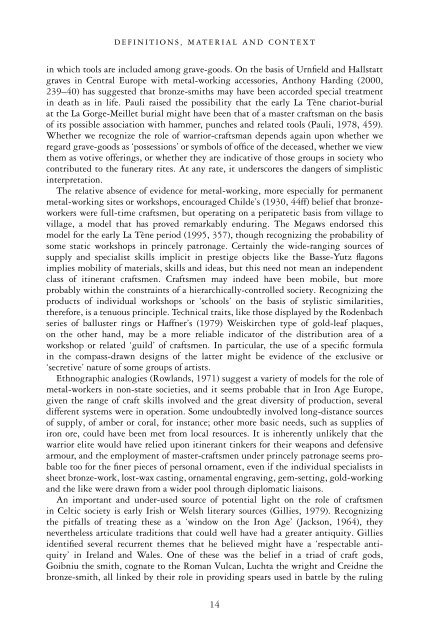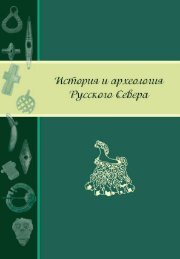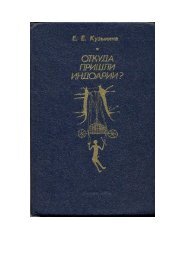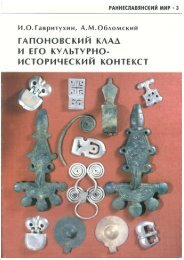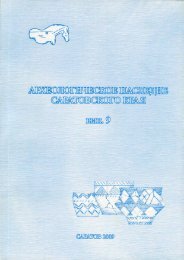The Archaeology of Celtic Art
The Archaeology of Celtic Art
The Archaeology of Celtic Art
- No tags were found...
You also want an ePaper? Increase the reach of your titles
YUMPU automatically turns print PDFs into web optimized ePapers that Google loves.
DEFINITIONS, MATERIAL AND CONTEXTin which tools are included among grave-goods. On the basis <strong>of</strong> Urnfield and Hallstattgraves in Central Europe with metal-working accessories, Anthony Harding (2000,239–40) has suggested that bronze-smiths may have been accorded special treatmentin death as in life. Pauli raised the possibility that the early La Tène chariot-burialat the La Gorge-Meillet burial might have been that <strong>of</strong> a master craftsman on the basis<strong>of</strong> its possible association with hammer, punches and related tools (Pauli, 1978, 459).Whether we recognize the role <strong>of</strong> warrior-craftsman depends again upon whether weregard grave-goods as ‘possessions’ or symbols <strong>of</strong> <strong>of</strong>fice <strong>of</strong> the deceased, whether we viewthem as votive <strong>of</strong>ferings, or whether they are indicative <strong>of</strong> those groups in society whocontributed to the funerary rites. At any rate, it underscores the dangers <strong>of</strong> simplisticinterpretation.<strong>The</strong> relative absence <strong>of</strong> evidence for metal-working, more especially for permanentmetal-working sites or workshops, encouraged Childe’s (1930, 44ff) belief that bronzeworkerswere full-time craftsmen, but operating on a peripatetic basis from village tovillage, a model that has proved remarkably enduring. <strong>The</strong> Megaws endorsed thismodel for the early La Tène period (1995, 357), though recognizing the probability <strong>of</strong>some static workshops in princely patronage. Certainly the wide-ranging sources <strong>of</strong>supply and specialist skills implicit in prestige objects like the Basse-Yutz flagonsimplies mobility <strong>of</strong> materials, skills and ideas, but this need not mean an independentclass <strong>of</strong> itinerant craftsmen. Craftsmen may indeed have been mobile, but moreprobably within the constraints <strong>of</strong> a hierarchically-controlled society. Recognizing theproducts <strong>of</strong> individual workshops or ‘schools’ on the basis <strong>of</strong> stylistic similarities,therefore, is a tenuous principle. Technical traits, like those displayed by the Rodenbachseries <strong>of</strong> balluster rings or Haffner’s (1979) Weiskirchen type <strong>of</strong> gold-leaf plaques,on the other hand, may be a more reliable indicator <strong>of</strong> the distribution area <strong>of</strong> aworkshop or related ‘guild’ <strong>of</strong> craftsmen. In particular, the use <strong>of</strong> a specific formulain the compass-drawn designs <strong>of</strong> the latter might be evidence <strong>of</strong> the exclusive or‘secretive’ nature <strong>of</strong> some groups <strong>of</strong> artists.Ethnographic analogies (Rowlands, 1971) suggest a variety <strong>of</strong> models for the role <strong>of</strong>metal-workers in non-state societies, and it seems probable that in Iron Age Europe,given the range <strong>of</strong> craft skills involved and the great diversity <strong>of</strong> production, severaldifferent systems were in operation. Some undoubtedly involved long-distance sources<strong>of</strong> supply, <strong>of</strong> amber or coral, for instance; other more basic needs, such as supplies <strong>of</strong>iron ore, could have been met from local resources. It is inherently unlikely that thewarrior elite would have relied upon itinerant tinkers for their weapons and defensivearmour, and the employment <strong>of</strong> master-craftsmen under princely patronage seems probabletoo for the finer pieces <strong>of</strong> personal ornament, even if the individual specialists insheet bronze-work, lost-wax casting, ornamental engraving, gem-setting, gold-workingand the like were drawn from a wider pool through diplomatic liaisons.An important and under-used source <strong>of</strong> potential light on the role <strong>of</strong> craftsmenin <strong>Celtic</strong> society is early Irish or Welsh literary sources (Gillies, 1979). Recognizingthe pitfalls <strong>of</strong> treating these as a ‘window on the Iron Age’ (Jackson, 1964), theynevertheless articulate traditions that could well have had a greater antiquity. Gilliesidentified several recurrent themes that he believed might have a ‘respectable antiquity’in Ireland and Wales. One <strong>of</strong> these was the belief in a triad <strong>of</strong> craft gods,Goibniu the smith, cognate to the Roman Vulcan, Luchta the wright and Creidne thebronze-smith, all linked by their role in providing spears used in battle by the ruling14


